Lots of recent trends in electronics have to do with either looks or convenience: We have 1080p HDTVs that deliver stunning visual detail, and remarkably small, stylish MP3 players that hold tons of tunes. But what about audio quality? Does your TV’s sound really do its picture justice? Do your favorite songs seem muddy or flat on your MP3 player?
Sound quality is a major part of the home A/V experience, but it sometimes gets overlooked. We’ve come up with 15 ways to help you get better sound, many of which are free. Think of your audio system as a chain. The source, the audio component, the connecting cables, the amplifier, the speakers — they all affect the sound you hear. But as you’ll see from our list below, just making small, simple improvements to individual parts of that audio chain can make a big difference.
Get better sound with these completely free tweaks
Tip #1: Seek out good recordings — the first link in the audio chain.
A well-engineered recording — whether it’s music or a movie soundtrack — can make any system sound like a star. Most music- and movie-review websites tend to focus on the artistic aspects of recordings, but a few of our favorites also rate sound quality. Playback is a monthly online magazine featuring capsule reviews of the latest music discs. Both the print and web versions of Stereophile magazine feature an annual list of “Records to Die For” penned by the magazine’s knowledgeable reviewers. And The Absolute Sound offers guides in a similar vein. Whether you like rock, jazz, classical, or all of the above, you’ll find intriguing suggestions.
Tip #2: Select a lower level of compression — or better quality — for your music files.
The iPod and MP3 phenomenon has created lots of new music listeners, many of whom might not realize that compressing music into small digital files can negatively impact sound quality. Your music ripping software probably comes set by default to remove up to 90% or more of the digital information found on the original CD. This makes storage convenient, but compromises sonic detail and clarity.
If you’ve got enough storage space on your iPod or computer, try selecting a higher “bitrate” setting in your music software, such as 256 Kbps (kilobits per second), when “ripping” tracks from your CDs. If you’re downloading music tracks from an online store, check out the technical specs of the files — more and more, you can find songs encoded at higher bitrates for little or no additional cost.
Higher-bitrate files are larger, but they also sound better. Programs like iTunes and Windows Media Player can also create “lossless” audio files, which maintain CD-quality sound while cutting the required storage space roughly in half. See our article about the MP3 format for more info.
Tip #3: Place your speakers carefully.
Your speakers are the “voice” of your system, and setting them up carefully can help you get the most out of your investment. Our article on positioning your speakers properly offers detailed placement instructions. But even after you’ve followed those suggestions, you may still be able to improve your setup with small adjustments. Have the member of your household with the most discerning ears sit in the main listening position, and check whether:
- the front speakers sound best facing directly into the room, or angled slightly inward toward the listener
- the center channel sounds better above or below the TV (assuming you have both options)
- your surround speakers are most effective when facing straight, or angled toward the main listening position.
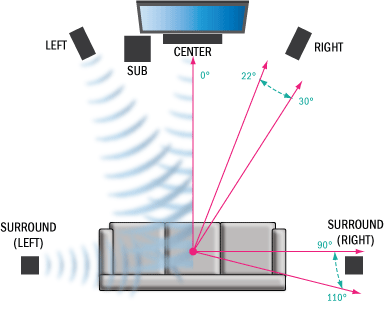
Take a little extra time to set up your speakers properly, and your ears will thank you.
Tip #4: Dial in your subwoofer’s settings.
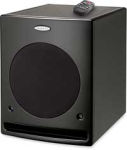
Powered subwoofers give you deep bass for your music and dramatic low-frequency effects for home theater. To get the best possible sound from your sub, make certain that its crossover and level settings are correctly adjusted. Dial in too much bass volume, and your low-frequency sounds become intrusive and overpowering. Set your crossover too high, and bass notes can sound boomy and unclear. Spending a little time to get it just right lets you enjoy bass that’s deep, well-defined, and nicely blended with the sound of your main speakers. Learn more about adjusting your powered sub.
Tip #5: Take advantage of your receiver’s auto setup features.
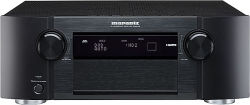
Most newer home theater receivers come with sound calibration features — from simple test tones that will help you balance channel volume, to sophisticated calibration systems that can measure speaker distances and sizes, then automatically adjust delay settings and frequency response to fit your room. Many receivers also provide additional manual adjustments that let you tweak the sound even further to match your own personal taste. Automatic calibration makes it much, much easier to tailor your receiver’s settings precisely to your particular speakers and listening room. Watch our video about automatic speaker calibration.
Tip #6: Use your receiver or disc player’s “Pure” mode for better sound.
Sending music signals through unnecessary circuitry can add unwanted noise and distortion to your favorite recordings. That’s why some receivers and disc players offer a “Pure” or “Direct” mode for playing music. These modes give you the option of switching off unused or unneeded portions of your component’s circuitry to provide the cleanest possible signal path, and minimize potential electronic interference. If any of your components provide these types of options, give them a try. You might find that the resulting sound is clearer and more detailed.
These upgrades give you great bang for your buck
Tip #7: Don’t settle for your TV’s built-in speakers.
TV cabinets have gotten thinner and thinner, leaving less and less room for built-in speakers. The result? Flat, muddy sound that just doesn’t do justice to today’s high-def displays. You’ve got a lot of options for improving your TV’s sound — from popular single-speaker sound bars to full surround sound systems, and everything in between. Many of these options are compact and simple to set up. See our article on four ways to improve your TV’s sound for more info.
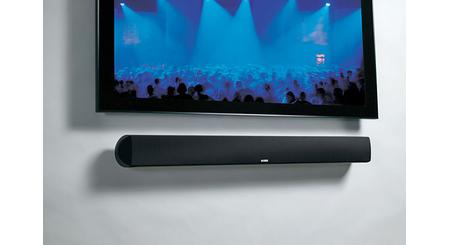
Tip #8: Take advantage of the latest surround sound formats from your Blu-ray player.

Many Blu-ray discs boast high-resolution surround sound from two new formats, Dolby® TrueHD and DTS-HD™ Master Audio. These formats provide ultra-detailed audio that rivals the original studio sound. If you’ve got a full surround sound system, you’ll be impressed by how immersive these state-of-the-art soundtracks can be, and how much they pull you into the on-screen action. To take advantage of these formats, pay close attention to how you connect your system:
- If you have a Blu-ray player with built-in decoding for Dolby TrueHD or DTS-HD Master Audio, you can connect it to your home theater receiver via HDMI or multichannel analog audio cables.
- If your Blu-ray player doesn’t have the necessary built-in decoding, you can pass the signal via HDMI to a receiver that can decode those formats.
For more info, see our article on choosing a Blu-ray player.
Tip #9: Try better speaker wire — a logical first step in upgrading your audio connections.
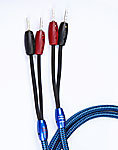
Most speakers don’t come with any wire, so you’ll need to get some kind of speaker wire to connect them to your receiver or amplifier. We’ve heard enough demos over the years to know that speaker wire can have a noticeable impact on the sound of your system. The higher the quality of your speakers, the more they’ll benefit from high-quality cables. Things to consider when shopping for speaker cables include gauge (thickness), length, construction, and connector type. For an expert recommendation, check with one of our Advisors — you can call them at 1-888-955-6000. Learn more about choosing speaker wire.
Tip #10: Biamp your speakers.
If you’ve purchased a home theater receiver in the last couple of years, it may have extra channels of amplifier power that you can put to use for better sound. That’s because most newer receivers have seven amplifier channels, while many people only use five speakers in their home theater setup.
If your receiver’s “surround back” channels are going unused, check if you can redirect the power to <span>biamp</span> your front left and right speakers. This neat trick gives you four dedicated amplifier channels to drive your front two speakers, essentially doubling the available power for more dynamic, higher-quality sound.
Note: Your receiver must be able to redirect unused amp channels, and your front speakers must each have two pairs of input terminals (also known as “biamp inputs”) as shown below.
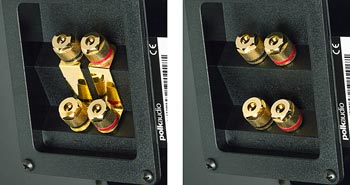
Dual sets of binding posts permit biamping or biwiring. These speakers come with jumpers that connect the two sets of binding posts for regular use (left photo). For biamping or biwiring, simply remove the jumpers (right photo).
Tip #11: Bypass your iPod’s built-in digital-to-analog converter.
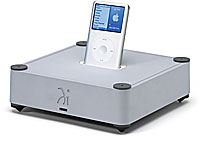
A digital-to-analog converter, or DAC, has the job of converting digital information — 0’s and 1’s — into analog music signals. The iPod’s built-in DAC usually does a good enough job for casual listening with earbud headphones, but it doesn’t deliver the same level of performance you can get from the more advanced DACs found in many of today’s audio/video receivers (or an even higher-end outboard DAC — see Tip #14). Fortunately, there is a special dock available that lets you bypass your iPod’s DAC — the Wadia 170iTransport. It lets you pass signals directly to your receiver or outboard DAC in the digital realm, for cleaner, fuller sound.
Tip #12: Use a power conditioner — protect your gear and improve its performance

Many people think nothing of plugging sensitive, high-performance audio and video components into a $5 power strip. Well, we don’t think much of it either. These general-purpose power strips don’t offer adequate protection against damaging power spikes, and they seldom filter out the everyday electronic interference from your home’s electrical appliances, phone lines, computers, and cable connections that can affect your system’s performance. Check out our power protection and conditioning units, or check out this article to learn more.
Higher-end options for really great sound
Tip #13: Use high-quality source components.

No matter how good your amp and speakers are, if they’re not receiving a richly detailed, high-quality signal then you’re not going to get all the performance they’re capable of. The only way to ensure that you’re enjoying all the sound quality you paid for is to use playback equipment that can extract every last bit of information from your source, be it analog or digital.
High-quality source components typically offer sturdier construction, costlier precision-built parts, and larger power supplies to help bring out subtle nuances in your music that you may not have heard before. Most listeners experience deeper, better-defined bass, smoother highs with more detail, and a greater sense of space and realism.
Some of our favorite high-quality source components are Marantz’s SA8003 SACD/CD player and TT-15S1 turntable.
Tip #14: Try a smokin’ outboard DAC — get shockingly good sound from your CD collection.
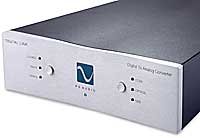
For nearly as long as CD players have been around, audiophiles have been enjoying richer CD sound by connecting an outboard DAC (digital-to-analog converter). A DAC’s only job is to convert digital bits, such as those from a CD or DVD player, into a stereo analog signal to feed to your receiver or preamp. You connect your player to a DAC using either an optical or coaxial digital cable, and then use a high-quality audio patch cable between the DAC and your receiver.
Tip #15: Upgrade to high-performance loudspeakers.

Your speakers are the part of your system you actually listen to, and upgrading your speakers is one of the most reliable ways to enhance the experience. Most of today’s speakers sound at least okay, but you have to do some digging to find the real gems. Polk’s speakers consistently deliver great bang for the buck, but if you’re looking for more involving sound, we recommend their LSi series. And if you’re looking for extremely detailed, low-distortion music reproduction, THIEL’s beautifully made speakers are world-renowned for their accurate sound.
- Learn more about choosing speakers.
- Read a review of the Polk LSi9 bookshelf speaker.
- Read a review of the THIEL SCS4 bookshelf speaker.
- Read a review of the THIEL CS3.7 floorstanding speaker.

Contributions by Dave Bar, Steve Kindig, James Ralston, and Amanda Moore, Crutchfield.com. All rights reserved. (reprinted with permission, originally posted November 7, 2008)





























